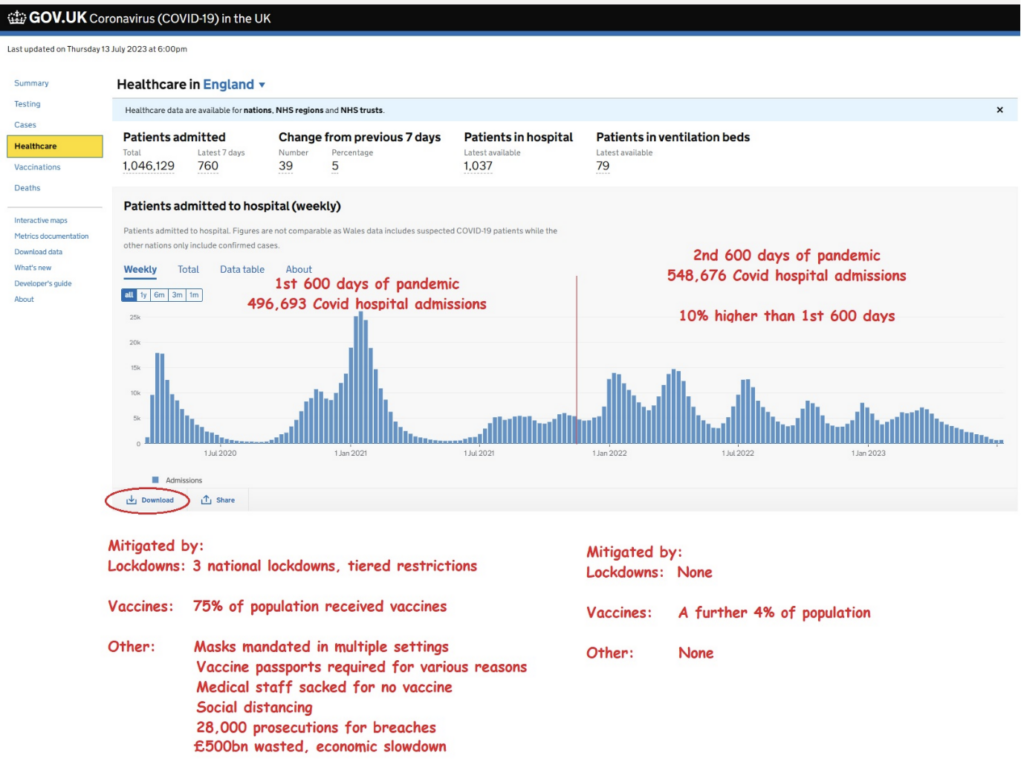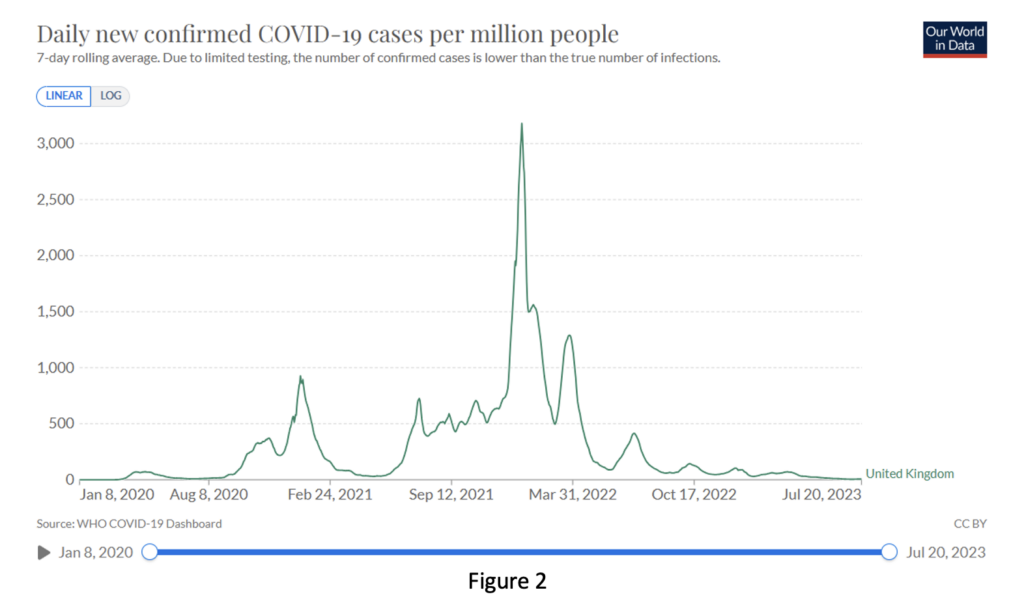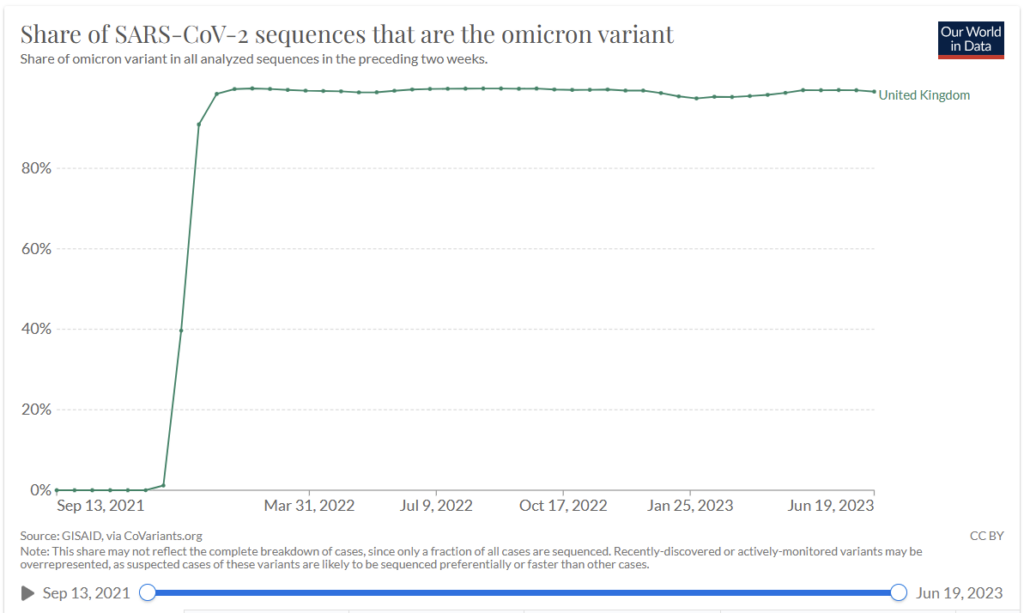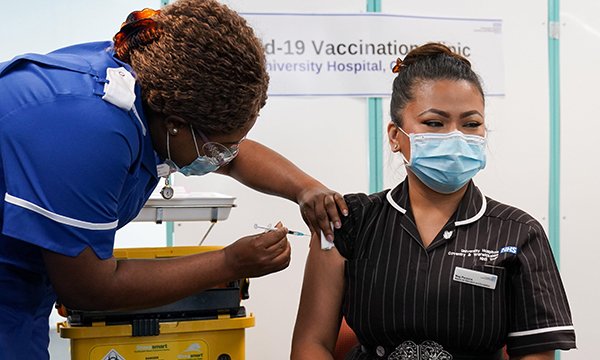The last day of June 2023 marked the 1,200th day since the start of the ‘pandemic’. Since March 20th, 2020, Covid hospital admission data has been reported on the Government’s Coronavirus Dashboard. In the first 600 days there had been 496,693 Covid hospital admissions in England. Oddly, in the second 600 days, there were 548,676 Covid hospital admissions. That’s right, hospital admissions were 10% higher in the period after vaccine take-up in the vulnerable groups had passed the 95% level.

It’s almost as if 230 million vaccine doses, the imposition of countless non-pharmaceutical interventions and spending £500 billion on ‘Covid support’ programmes made no difference to hospital admission numbers.
But, of course, things that run against the ‘narrative’ are commonplace and usually go unremarked. I confess that as time passes, I forget just how bonkers it all was. For example, in addition to our own Sages, we had Albert Bourla, Chairman and CEO of Pfizer, along with Gates, Biden, Fauci, et al., telling us throughout 2021 that vaccines stopped transmission. I’m sure, like me, you’ll still hear people say, “But they never said that vaccines would stop transmission.” Then please tell me, what was the point of a vaccine passport if it was understood that vaccination didn’t stop transmission? Like so much else, it’s been memory-holed.
Just as a quick reminder, here’s Our World in Data’s chart for ‘confirmed cases’. Bearing in mind that the vaccine rollout was largely complete by the summer of 2021, isn’t it odd that cases peaked in January 2022 at over three times the previous high?

Figure three shows two charts from Our World in Data. On the left, we have cumulative vaccine shots. On the right ‘new cases’ per million of population.
November 11th, 2021, marked the 600th day since the start of the pandemic. By then we’d injected 160 doses of vaccine per 100 of population. Among the elderly and vulnerable, over 95% were reportedly ‘fully vaccinated’, and most had received at least one booster shot. As cases peaked on January 5th, vaccine doses had reached 199/100 of population. Clearly, vaccines didn’t do much to stop transmission!

However, this article isn’t about ‘cases’; it’s about hospital admissions. Once it was understood that vaccines did nothing to stop transmission, the narrative shifted: “Vaccines might not stop transmission, but they stop you being hospitalised or dying.” I, along with many others, including the ONS, have demonstrated that vaccination made no ‘real-world’ difference to your chances of dying of Covid. An article I wrote in the Daily Sceptic published on July 27th, 2022, pointed out that: “ONS data on deaths by vaccination status show that of the 5,678 Covid deaths in April and May 2022, 93% were of vaccinated people.” Given that significantly less than 93% of the population were vaccinated, this wasn’t a great result for vaccine supporters. But, until now, I hadn’t looked at hospital admissions.
As figure one (above) illustrates, there were more Covid hospital admissions after the vaccine rollout than before. But, so the narrative goes, people hospitalised after vaccination were hospitalised ‘with’ Covid, not ‘because’ of Covid. Let’s test that one.
When Sajid Javid replaced Matt Hancock as Health Secretary in June 2021, he was keen to differentiate between hospital patients admitted due to complications from Covid and those who were admitted primarily for something else but who incidentally tested positive for Covid. The results can be viewed here. There are four reports, starting from June 18th, 2021, with data going up to the end of May 2023. Figure four presents the data as a chart.

Looking at the grey line related to the percentage scale on the right, we can see that the percentage of admissions ‘primarily’ due to Covid hovered around the 75% level from June 18th, 2021, until early December 2021. Through the winter of 21/22, this percentage declined dramatically until it stabilised at around 35% in April/May 2022. So, what happened through late 2021 and early 2022 that caused the number of Covid hospital admissions to go from ‘primarily’ admitted due to Covid to where Covid was an incidental diagnosis for 65% of them? Was it vaccination? No. Vaccines had been rolled out a year earlier back in winter/spring 2021. It was Omicron.

As figure five shows, Omicron went from 1% of all cases on December 6th, 2021, to 99% of all cases by January 31st, 2022. Clearly, the change in the proportion of patients hospitalised due to Covid over the period covered by these NHS reports didn’t reduce due to vaccination but due to the milder nature of the prevailing Covid variant.
Any impact the vaccines may have had on hospital admissions occurred prior to Sajid Javid’s drive to collect data on the reason for admission. From when these data started being collected, on June 18th, 2021, figure four shows us that about 75% of hospital admissions were ‘primarily’ due to Covid. The critical question is, can we get data on the primary cause of hospital Covid admissions prior to that date?
A paper produced by SAGE on behalf of the Government looked at nosocomial infections up to the end of July 2020. It estimated that about 75% of Covid admissions were ‘for’ Covid rather than ‘with’ Covid. Covid hospital admissions varied significantly with seasonality and whatever other factors affect rates of transmission, but it seems likely that the ‘primary’ diagnosis of Covid stayed fairly stable at around 75% right through 2020 and 2021, up to the point in December 2021 when Omicron arrived.
Clearly, the main takeaway is that as with ‘cases’ and deaths, it was the arrival of Omicron rather than the rollout of vaccines that made the difference.
But you have to admit, it’s a great pub-quiz question: when were there more Covid hospital admissions, in the first or second 600 days of the pandemic?














To join in with the discussion please make a donation to The Daily Sceptic.
Profanity and abuse will be removed and may lead to a permanent ban.
Rep. Jim Jordan, who inquired to the former Trump administration official: “When the government told us that the vaccinated couldn’t transmit it, was that a lie or is it a guess?”
“I think it was hope that the vaccine would work in that way,” Birx replied.
https://naturalnews.com/2022-07-04-vaccine-mandates-predicated-on-hope-rather-science.html
Cut the excuse making wankers:
“Yes but ‘long-covid’”
“My granny deferred seeing her GP because she didn’t want to overwhelm the NHS”
”Tory underfunding”
What’s one more death jab sneaking onto the market? We’ll be expecting an official investigation into the excess deaths/injuries from the deployment of these gene therapies any day now, obviously…
”Bimervax, the COVID-19 vaccine developed by HIPRA Human Health, has today been authorised by the Medicines and Healthcare products Regulatory Agency (MHRA).
It becomes the 9th COVID-19 vaccine to be authorised by the UK’s independent medicines regulator.
Bimervax combines a part of the SARS-CoV-2 virus spike protein with an ‘adjuvant’ – an additional ingredient designed to trigger a stronger immune response. It can be given as a booster injection in the upper arm, to those aged 16 years and over.
The clinical evidence for this authorisation is based on data from a study of 765 adults who had received primary vaccination with 2 doses of the Comirnaty COVID-19 vaccine and who were given a booster dose of either Bimervax or Comirnaty. The vaccine demonstrated a strong immune response, and the most common side effects were mild, and self-resolved within a few days of vaccination.”
https://www.gov.uk/government/news/bimervax-covid-19-vaccine-authorised-by-mhra
Just a reminder of the now infamous June Raine’s ”..from watchdog to enabler” clip, so as we can all feel rest assured, you know?
https://twitter.com/BandyGit/status/1686685964557545472
So we are still on emergency approval, although there is no emergency? That is doublkethink of the worst kind. 1984 here we come, and it is almost complete! This is a me too response to a manufacturer from an alleged regulator that is so far as to be fit for purpose as to be criminally liable. So much for Quangos, ban the lot!
Nick, thank you for putting pandemic in inverted commas. So important.
If SAGE estimated that 75% of COVID admissions where because of COVID and not because of a positive test upon entering hospital for an unrelated reason, it’s a safe assumption that the real number was close enough to 25% (probably from below) that they had to admit something to muddy the waters. And then, there’s of course the estimated.
If records had been kept proberly, nobody would need to have estimated the number as it would have been known. This is a tacit admission that – at no point during this ‘pandemic’ – the pandemistas really knew the number of COVID hospital admission because they really didn’t even want to know them. Which – in turn – implies that the pandemic of headlines and restrictions never coincided with a mass-outbreak of a highly infective and very dangerous disease. Otherwise, it wouldn’t have been possible to turn a blind eye to reality.
The shocking bit here is how cheaply done all of these fabrications where. Eg, people listening to Ferguson despite his record of gross mispredictions on anything. If you really want know what’s going to happen in future, ask Professor Pantsdown and bank on the polar opposite happening.
Remember too that a PCR test did not show active infection, just that there might have been some contact. Remember 40 cycles is useless for diagnosis of active, 20 is more reasonable as an active infection indicator. Everything was lies from top to bottom. The figure was more likely to be 1%.
It will be interesting, if that’s the right word, to see what happens in future.
Shouldn’t we have seen a reductiion due to seasonality, dry tinder already gone and herd immunity?
It sems as though “covid” is still very prevelant and circulating widely, entirely as GVB predicted, due to the criminal folly of jabbing erstwhile fit populations with a none sterilising jab.
GVB also says it’s a myth that virus always mutate to a more benign/more transmissible state. Their apparent seasonality effect is mainly (obviously lack of warmth/sun/vitaminD3 are factors) due to herd immunity being achieved in the general population during winter exposure – which we can’t achieve due to the jab.
If he’s correct on the latter point, the jabbed world is in big trouble.
‘I confess that as time passes, I forget just how bonkers it all was. For example, in addition to our own Sages, we had Albert Bourla, Chairman and CEO of Pfizer, along with Gates, Biden, Fauci, et al., telling us throughout 2021 that vaccines stopped transmission. I’m sure, like me, you’ll still hear people say, “But they never said that vaccines would stop transmission.”’
Would you believe that a trusted expert speaking on the trusted BBC, as long ago as three days ago, is still claiming that the Covid vaccine prevents transmission?
If you find that hard to believe, listen for yourself, if you can bear it:
Dr Sarah Pitt – a “leading virologist” and “a microbiologist at the University of Brighton and fellow of the Institute of Biomedical Science” – clearly suggested on BBC Radio 5 Live on Sunday night that the vaccine prevents transmission. Talking to Stephen Nolan, 2:47:00 to 2.47:37 into the programme, here:
https://www.bbc.co.uk/sounds/play/m001p6ys
Dr Pitt said that if anyone is offered a booster vaccine:
“then they should definitely take it, because it’s much better not to get Covid, because it’s a really really nasty infection, and can have some very serious consequences for you, and you also don’t want to be passing it on to the people around you for the same reason, so definitely have the vaccine, if it’s offered to you.”
A couple of minutes earlier – at 2:45:40 – she stated that the vaccine is “very safe and very effective” and that if you “unfortunately experience quite severe side effects”, if you get to the hospital in time, you not only might be okay but you also have protection against Covid!
So that’s all good!
Anybody still proclaiming this codswallop after this long and after all the evidence that has been compiled which refutes these claims just sounds like they’re in the tight grasp of religious fervour, because it really has become more of a belief system for these cult figures now, in my opinion. They make baseless claims with nothing in the way of scientific evidence to back up their statements. They’re just saying words, basically. Pitiful really and should amount to career suicide if it weren’t for the fact we’re living in

Anybody with vaccine damage should sue her, come on lawyers, this is a good class action opportunity!
Absolutely brilliant thankyou, I needed a laugh. Good to know there is an alternative universe. I might apply to Brighton University to see if I can also pick up a clown Phd, will they accept my village idiot Bsc and my fuckwitt Msc as entrance?
Undoubtedly. You simply need to write a meaningless thesis praising every one of these “Covid experts”. You can copy their data, I’m sure they have so much supporting this!
Bourla, Fauci etc said it stopped transmission. The Pfizer study itself was never designed to test for transmission.
They cannot remeber saying this, now known as the Biden excuse!